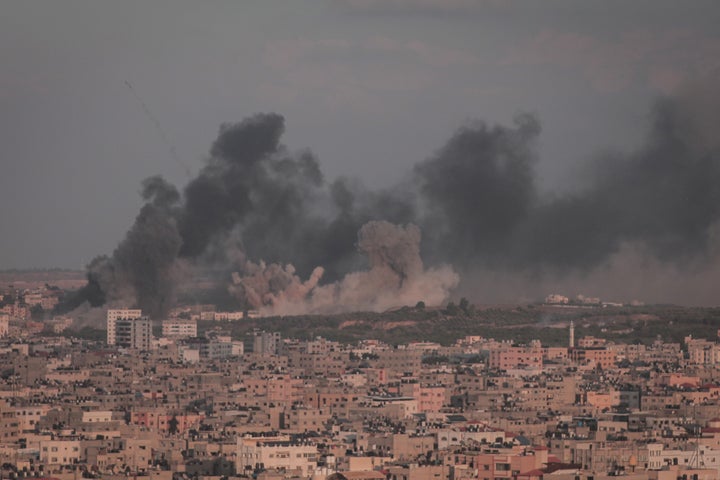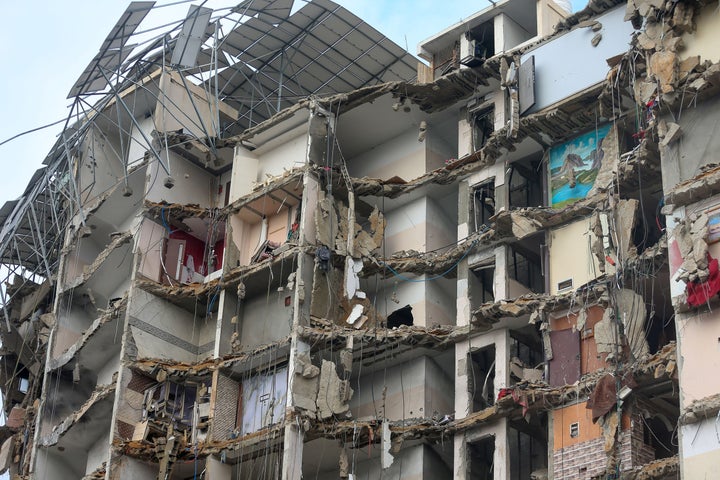This week’s crisis in Israel-Palestine began with a vicious, unprecedented offensive against Israeli communities. Now the flare-up is expected to mostly play out in occupied Palestinian territory — specifically in Gaza, the coastal enclave from which Hamas militants launched their October 7 attack.
The Israeli military has been bombarding Gaza since the weekend, killing nearly 800 people. Many international officials and national security experts believe Israel will soon launch a ground invasion of Gaza with the stated goal of exacting revenge upon the territory’s ruling party, Hamas, and other armed Palestinian groups.
It’s clear that Israel’s operation will have dire consequences for nearly everyone in the densely populated area. Already, the chief hospital in Gaza City looks like “a slaughterhouse,” Mahmoud Shalabi of the charity Medical Aid for Palestinians told the BBC. The United Nations said Tuesday in a statement that nearly 200,000 Gazans have been displaced from their homes.
Israel is imposing what its defence minister called “a complete siege on Gaza… no electricity, no food, no water, no fuel” and has repeatedly bombed the only exit point from Gaza into another country, the Rafah crossing into Egypt.
“The emphasis is on damage and not on accuracy,” Israeli Defense Forces spokesperson Daniel Hagari told journalists on Tuesday, while Mark Regev, an adviser to Israel’s leader, told CNN he expected “a new reality in Gaza.”
Amid worldwide shock over the assault on Israel, there’s little international pressure for Israeli restraint in the name of recognising the difference between the perpetrators and ordinary people.
Asked by reporters on Monday evening whether the U.S. wants its Israeli counterparts to refrain from collective punishment of Gazans, White House spokesperson John Kirby said: “Israel has the right to defend itself… We and Israel, as democracies, we have a lot of shared values, [and] one of those shared values is respect for life, the kind Hamas is not showing at all.”
The toll of Israel’s operation — and the prolonged conflict that will likely ensue as Hamas and its allies retaliate against Israeli targets, prompting more Israeli retribution — will be tremendous. Gaza, a battered strip of land that hosts 2.3 million people in desperate conditions, is set to be one of the world’s bleakest battlefields.
A Dark Familiarity
Gazans are among the globe’s most impoverished groups, with the majority living in refugee camps and relying on humanitarian aid. They have repeatedly suffered during fighting between Israel and militant Palestinian organisations.
After Israel withdrew from the territory in 2005 — retaining control of most of its borders and critical infrastructure — Hamas won elections there in 2006 and took over in 2007. Since then, Israel has blockaded Gaza and launched major offensives against it in 2008, 2012, 2014 and 2021, as well as several smaller operations. Some involved significant civilian casualties, like a months-long Israeli crackdown on protesters at the Israel-Gaza border in 2018.
The current Israeli campaign has so far targeted a number of residential areas and damaged multiple hospitals, mosques and aid facilities. Israel’s pledges to make Hamas pay a massive price suggest it will continue to hit a broad range of targets. And its self-proclaimed siege, which U.N. experts described as “collective punishment,” will likely lead to painful shortages.
“During the darkest hours of our presence in Gaza we never envisaged a scenario where 2 million civilians could possibly live through heavy bombing, deprived of water, food, electricity [and] medicines,” Fabrizio Carboni, the regional director for the International Committee of the Red Cross, wrote on X on Monday. “All measures to avoid such a situation should be taken immediately.”
Ghada Kord, a freelance journalist in Gaza, told HuffPost she already feels like she’s in a nightmare. She can’t shake the scent of the dead bodies of humans, dogs and cats that she saw on the ground immediately after a recent Israeli airstrike hit the center of Gaza City.
The lack of fuel and closed-down streets mean that ambulances can’t access people who have been killed and injured, Kord said. She has no electricity, and her internet is spotty. Pharmacies and clinics have shut down. A blanket of smoke has filled the sky.
“Two million people live in Gaza – not all of them belong to [armed] factions. They are civilians,” she said.
Kord hasn’t been able to contact her own family yet. She knows it’s only going to get worse.
“We are going to face a huge disaster,” she said.

Israeli officials have warned Gazan civilians before striking particular neighborhoods and suggested that some should consider leaving the Palestinian territory altogether.
Fear of assaults on certain areas has fueled massive displacement, with the U.N. estimating that 187,518 Gazans have left their homes to seek shelter elsewhere in the strip — more than 137,000 of them at U.N. schools, which are becoming overcrowded and face concerns about their water supply.
Meanwhile, fleeing Gaza is almost impossible. The region’s southern neighbor Egypt is reluctant to open the Rafah crossing into its territory — which both the U.S. State Department and the Israeli military have highlighted as an option — amid Israeli airstrikes and Egypt’s fear of a huge refugee influx, and Israel has blocked all other routes into and out of Gaza.
The total disruption of life in the strip has already limited residents’ access to vital supplies.
The U.N. Relief and Works Agency, which focuses on Palestinian refugees and is a major player in Gaza’s fragile economy, has been unable to provide this week’s food rations to nearly 500,000 people — one-fifth of the region’s population — the agency said in a Tuesday statement. One-third of Gaza’s health centers are closed, and only 13.5% of its health care staff is at work, the UNRWA statement continued.
Gaza typically relies on the Israeli power grid but is currently dependent on its own small local power plant, which only runs for four hours a day, and private fuel supplies, which have limited diesel reserves, the Israeli human rights group B’Tselem and the charity Oxfam said in Tuesday press releases. Electricity shortages will make it harder to purify drinking water, charge cellphones and access the internet. Airstrikes have so far disrupted access to water and sanitation for 400,000 Gazans and shut down Gaza’s wastewater treatment plant, leading to raw sewage being emitted into the Mediterranean Sea, according to Oxfam.
“It’s a very difficult situation — not knowing if you’re going to live the next day, the next hour or the next minute.”
- Nadia Hararah, Palestinian American marketing manager with family in Gaza
Abood Okal, a 36-year-old Palestinian-American, arrived in Gaza two weeks ago to visit family members there whom he hadn’t seen for six years. He was happy to introduce his 1-year-old to his uncle, aunt and cousins. But now, Okal is sheltering in place, unable to see his parents — American citizens who are just 10 minutes away. A bomb has blown out the windows and doors of their home.
“It’s a difficult humanitarian situation that’s unthinkable,” Okal told HuffPost. “Thousands of people are on the streets with no shelter, no power, and very soon will run out of water.”
Okal and his wife have been trying to distract their son from the bombs, clapping and telling him the booming noises are from fireworks. But as the strikes keep pouring down, it’s becoming increasingly difficult to hide the truth: “We’re running out of tricks up our sleeves to keep him unaware,” Okal said.
Gazans will also have to contend with the challenge of living in tightly packed communities where street fighting is likely to be extremely dangerous.
Additionally, regular Gaza residents have little say over the battle strategy of Hamas, which has tightened its control over the strip, declining to hold elections and rarely tolerating local dissent. Hamas has suggested it might kill Israeli hostages in retribution for Israeli airstrikes — a tactic that could lead to an even bloodier escalation — and its sophisticated military bulwarks throughout the strip will likely ensure any direct clash with Israeli forces is prolonged.

The death toll has already spiraled in just four days. In Virginia, Palestinian American Hani Almadhoun learned Monday morning from a Telegram chat that an Israeli airstrike killed 14 members of his family, including five children and elderly relatives.
“Death comes very fast,” Almadhoun told HuffPost. “We don’t get any solidarity.”
He hasn’t been able to reach his family in Gaza for the last four days. Almadhoun, who was just in the region two months ago, fears what is to come.
“We are afraid to look at media,” Almadhoun said. “It’s going to be another trauma.”
Slim Hopes
Few observers believe Israel can be persuaded to refrain from a major operation in Gaza.
The country’s foreign partners are encouraging caution to some degree. On Tuesday, President Joe Biden said he asked Israeli Prime Minister Benjamin Netanyahu to abide by international standards. “Terrorists purposely target civilians and kill them. We uphold the laws of war,” Biden said. “It matters. There’s a difference.”
The foreign ministers of the 27 nations in the European Union said they would like to see humanitarian corridors out of Gaza and urged Israel not to fully cut off supplies to the strip.
Yet demands for a broader halt in hostilities — like a ceasefire — remained marginal. And humanitarian aid for Gazans was not mentioned in a joint statement that Biden and the U.S.’s closest allies released Monday, drawing ire from some aid workers.
In 2014, when Israel launched a ground invasion of Gaza, it ultimately killed 2,251 Palestinians — including 551 children — and injured more than 11,000, per U.N. estimates.
Nadia Hararah, a Palestinian American marketing manager in Seattle, is unable to process her grief. Five of her cousins were killed on Saturday, and she’s worried about other relatives in the region.
“It’s a very difficult situation — not knowing if you’re going to live the next day, the next hour or the next minute,” she said.
She feels helpless and frustrated, unpacking a trauma she said is never-ending.
“I wish more Americans knew about how long and how deep the suffering has been at the hands of the Israeli occupation forces,” Hararah said. “They don’t recognize that this isn’t out of thin air. That me and my family have been suffering — differently, but suffering for a long time.”
